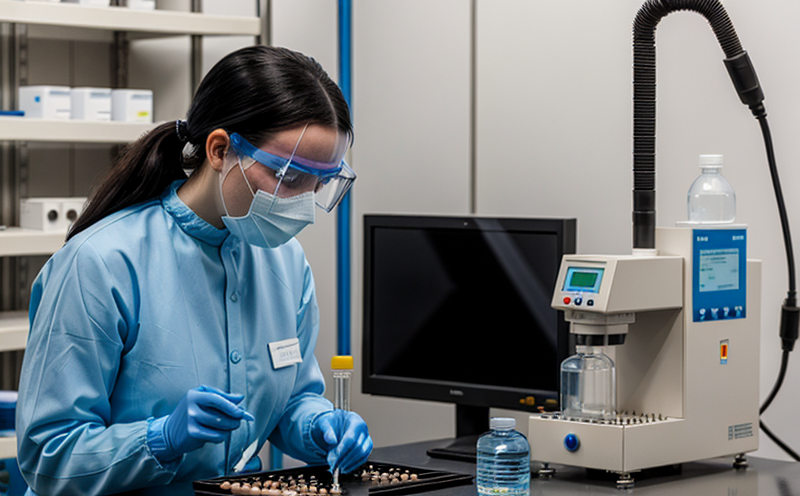Carbonyl Impurity Profiling by DNPH HPLC Testing
The process of carbonyl impurity profiling using DNPH (N-(dimethylamino) phenylhydrazone) derivatization coupled with High-Performance Liquid Chromatography (HPLC) is a critical analytical method used in pharmaceutical testing. This technique is particularly useful for identifying and quantifying trace amounts of carbonyl-containing compounds, which are often present as impurities or degradation products in pharmaceuticals.
The DNPH derivatization reaction is highly selective towards aldehydes and ketones, converting them into stable hydrazone derivatives that can be analyzed by HPLC. This method offers several advantages over other analytical techniques: it provides high sensitivity, selectivity, and the ability to resolve closely related compounds. The process involves a series of steps including sample preparation, derivatization, chromatography, and detection.
Sample preparation is crucial for ensuring accurate results. This includes extracting carbonyl-containing compounds from the pharmaceutical matrix using appropriate solvents followed by thorough purification. Derivatization with DNPH ensures that even very low levels of carbonyls are detectable after the reaction forms stable derivatives.
The HPLC system typically comprises a pump, autosampler, column oven, detector, and data acquisition software. The column used is optimized for efficient separation of complex mixtures containing carbonyl impurities. Detection is usually performed using UV-Vis or fluorescence detectors tailored to detect the DNPH-hydrazone derivatives.
Acceptance criteria for this method are stringent, ensuring that only reliable results are reported. These include linearity over a wide range of concentrations, precision with CVs less than 5%, and accuracy within ±2% of true values. Method validation is conducted according to international standards such as USP and ICH Q3D.
The method has been validated for various types of pharmaceutical compounds including APIs (active pharmaceutical ingredients), excipients, and formulated products. It can be applied across different dosage forms like tablets, capsules, injections, and creams.
| Application | Description |
|---|---|
| Quality Control | Detection of carbonyl impurities during batch release testing. |
| R&D | Identification and quantification of carbonyl-containing degradation products in new drug candidates. |
| Regulatory Compliance | Ensuring compliance with regulatory requirements for impurity profiling. |
The data generated from this method provides valuable insights into the stability and quality of pharmaceuticals, helping manufacturers make informed decisions about process improvements and formulation changes. By leveraging DNPH HPLC testing, pharma companies can ensure product safety and efficacy while adhering to stringent regulatory standards.
Applied Standards
The carbonyl impurity profiling by DNPH HPLC method is validated according to several recognized international guidelines. These include USP , which specifies the general requirements for impurities in pharmaceutical products, and ICH Q3D, which provides guidance on reducing impurities in drug substances.
USP mandates that all active ingredients must be tested for carbonyl-containing impurities. This standard ensures that drugs meet high quality standards by setting limits on the amount of these impurities allowed. The method described here adheres to these guidelines, ensuring accurate and reliable results.
ICH Q3D focuses specifically on reducing impurities in drug substances through good manufacturing practices (GMP). It emphasizes the importance of identifying potential sources of carbonyl-containing compounds during product development and production. Compliance with ICH Q3D ensures that pharmaceuticals are safe, effective, and of high quality.
Incorporating these standards into the testing process enhances confidence in the results and supports regulatory compliance. By adhering to USP and ICH Q3D, laboratories can ensure they are meeting the highest industry standards for carbonyl impurity profiling.
Industry Applications
The carbonyl impurity profiling by DNPH HPLC testing finds application across various segments of the pharmaceutical industry. This includes quality control laboratories, R&D departments, and regulatory affairs teams. Below are some specific applications:
- Quality Control: Detection of carbonyl impurities during batch release testing ensures that only compliant batches proceed to market.
- R&D: Identification and quantification of carbonyl-containing degradation products in new drug candidates helps optimize formulations and improve product quality.
- Regulatory Compliance: Ensuring compliance with regulatory requirements for impurity profiling, especially those outlined by USP and ICH Q3D.
- Patient Safety: Reducing the risk of adverse reactions due to impurities in pharmaceuticals.
- Sustainability: Minimizing waste generation during manufacturing processes by identifying and eliminating sources of carbonyl-containing impurities.
By addressing these critical aspects, carbonyl impurity profiling plays a pivotal role in maintaining the integrity and safety of pharmaceutical products throughout their lifecycle.
Use Cases and Application Examples
The following are some real-world use cases where carbonyl impurity profiling by DNPH HPLC testing is applied:
- Batch Release Testing: Ensuring that each batch of a drug meets quality standards before release to the market.
- Process Optimization: Identifying and quantifying carbonyl-containing compounds during process development to optimize manufacturing processes.
- Degradation Product Identification: Detecting and characterizing degradation products in new drug candidates to ensure their stability over time.
- Compliance Audits: Providing robust data for compliance audits conducted by regulatory bodies like the FDA, EMA, and MHRA.
- Patient Safety Monitoring: Continuously monitoring carbonyl impurities in marketed products to safeguard patient health.
- Sustainability Initiatives: Supporting sustainability efforts by minimizing waste generation through improved process control.
These use cases highlight the versatility and importance of DNPH HPLC testing in ensuring drug quality, safety, and compliance with regulatory standards.





